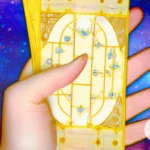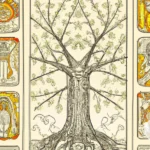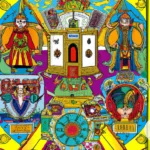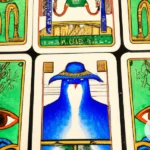As tarot readers, we often find ourselves delving deeper into the mystical and esoteric aspects of divination. The Tree of Life, an important symbol in Kabbalah, has long been used as a tool for spiritual growth and understanding. But how does it relate to the practice of tarot? In this article, we will explore the connections between the Tree of Life and tarot, uncovering the intricate correspondences that reveal hidden meanings and insights. Join us on this journey of discovery as we unravel the mysteries of the Tree of Life and its relationship to tarot.
The Tree of Life

The Tree of Life is an essential concept in Kabbalah and is often used to gain a deeper understanding of the universe and the divine. It is also used in Tarot to explore the interconnectedness of the universe and the different elements that make up our lives. Understanding the Tree of Life is crucial for anyone who wants a more profound understanding of Tarot, as many Tarot decks incorporate its symbols and concepts into their designs. In this section, we’ll delve into the nuances of the Tree of Life and its importance to Tarot. To learn more about how the Tree of Life and Kabbalah relate to Tarot, check out Understanding the Major Arcana through Kabbalah and Kabbalistic Court Cards. If you want to learn more about the individual sephiroth, go to The Ten Sephiroth in Tarot Meaning.
The Sephiroth
The Sephiroth is a fundamental concept of the Tree of Life in Kabbalah, which can be seen as ten emanations or levels of divine energy that make up the Tree. Each Sephira is represented by a sphere on the Tree, and is associated with specific qualities and correspondences.
Here are the ten Sephiroth and their corresponding meanings:
- Kether (Crown) – represents unity, perfection, and the divine. It is the highest and most abstract level on the Tree.
- Chokmah (Wisdom) – represents the first manifestation of divine energy, creation, insight, and inspiration.
- Binah (Understanding) – represents comprehension, analysis, and the power of intuition. It is the level of the feminine aspect of divinity.
- Chesed (Mercy) – represents love, compassion, and abundance. It is the level of benevolent power.
- Geburah (Severity) – represents strength, discipline, and justice. It is the level of divine punishment and karmic law.
- Tiphareth (Beauty) – represents balance, harmony, and transformation. It is the level of the central pillar on the Tree, and is considered the heart of the Tree.
- Netzach (Victory) – represents creativity, enthusiasm, and perseverance. It is the level of the divine warrior and the pursuit of excellence.
- Hod (Glory) – represents logic, analysis, and the power of the mind. It is the level of divine communication and the energy of speech.
- Yesod (Foundation) – represents the power of the imagination, the subconscious mind, and the gateway to the physical world.
- Malkuth (Kingdom) – represents the physical world, material existence, and the manifestation of divine energy in tangible form.
Understanding the Sephiroth is crucial to exploring the correspondences between the Tree of Life and Tarot. By understanding the qualities of each Sephira, we can better understand the meanings and associations of the Tarot cards that correspond to that Sephira. For example, the card corresponding to Kether, the highest Sephira, is the Fool, which represents new beginnings, freedom, and infinite potential.
Exploring the Sephiroth and their correspondences in Tarot can enhance our understanding of both systems, and help us gain deeper insight and presence in our Tarot practice.
The Paths
The Paths on the Tree of Life represent the connections or bridges between the Sephiroth. There are 22 Paths in total, corresponding to the 22 Major Arcana cards in the Tarot. Each of the Paths is assigned a specific Hebrew letter, astrological sign, and element.
Below is a table showcasing the correspondences of the Paths:
| Path Number | Hebrew Letter | Astrological Sign | Element | Major Arcana Card |
|---|---|---|---|---|
| 11 | Kaph | Jupiter | Water | Justice |
| 12 | Lamed | Libra | Air | The Hanged Man |
| 13 | Mem | Water | Water | Death |
| 14 | Nun | Scorpio | Water | Temperance |
| 15 | Samekh | Sagittarius | Fire | The Devil |
| 16 | Ayin | Capricorn | Earth | The Tower |
| 17 | Peh | Mars | Fire | The Star |
| 18 | Tzaddi | Aquarius | Air | The Moon |
| 19 | Qoph | Pisces | Water | The Sun |
| 20 | Resh | Sun | Fire | Judgment |
| 21 | Shin | Spirit | Fire | The World |
| 22 | Tav | Saturn | Earth | The Fool |
The correspondences of the Paths can be used in Tarot readings to provide a deeper understanding of the connections between the cards in a spread. For example, if the Path of the Hanged Man appears in a reading, it may suggest a need to surrender or let go of something in order to move forward. Similarly, if the Path of the Tower appears, it may suggest a sudden change or upheaval in the querent’s life. Exploring the connections between the Paths and the Tarot can lead to a greater appreciation and understanding of both systems.
Tarot and the Tree of Life
As we delve deeper into the study of the Tree of Life, it becomes evident that the Tarot is inherently intertwined with this ancient diagram. The Tarot is a divinatory system that utilizes a deck of 78 cards to gain insight into the past, present, and future. But what many do not know is that the 22 cards of the Major Arcana and the four suits of the Minor Arcana correspond to the sephiroth and paths of the Tree of Life. The Tarot and the Tree of Life are powerful tools that, when used in tandem, unlock a wealth of knowledge and understanding. So let’s take a closer look at how these two systems complement each other.
Major Arcana
The Major Arcana cards in the Tarot deck are intrinsically linked to the Tree of Life. Each card corresponds to a specific Sephirah or path on the Tree, representing different stages of spiritual evolution and growth.
Let’s delve into each card and its corresponding Tree of Life correspondence:
- The Fool (0): Malkuth – The Fool represents the beginning of the journey and is associated with Malkuth, the Sephirah of physical reality and manifestation.
- The Magician (I): Kether – The Magician is tied to Kether, the highest Sephirah and the source of divine energy.
- The High Priestess (II): Chokmah – The High Priestess corresponds to Chokmah, the Sephirah of wisdom and understanding.
- The Empress (III): Binah – The Empress is associated with Binah, the Sephirah of intuition and feminine energy.
- The Emperor (IV): Chesed – The Emperor corresponds to Chesed, the Sephirah of authority and structure.
- The Hierophant (V): Tiphareth – The Hierophant is tied to Tiphareth, the Sephirah of balance and harmony.
- The Lovers (VI): Netzach – The Lovers represent Netzach, the Sephirah of emotions and desire.
- The Chariot (VII): Geburah – The Chariot corresponds to Geburah, the Sephirah of strength and courage.
- Strength (VIII): Chesed – Strength is associated with Chesed, like The Emperor, the Sephirah of authority and power.
- The Hermit (IX): Yesod – The Hermit represents Yesod, the Sephirah of spirituality and subconsciousness.
- Wheel of Fortune (X): Kether to Tiphareth – The Wheel of Fortune is tied to the path between Kether and Tiphareth, representing the cycle of life and karma.
- Justice (XI): Geburah – Justice corresponds to Geburah, like The Chariot, the Sephirah of strength and severity.
- The Hanged Man (XII): Netzach – The Hanged Man represents Netzach, like The Lovers, the Sephirah of emotional response.
- Death (XIII): Tiphareth to Netzach – Death is associated with the path between Tiphareth and Netzach, representing transformation and rebirth.
- Temperance (XIV): Netzach to Yesod – Temperance corresponds to the path between Netzach and Yesod, representing balance and moderation.
- The Devil (XV): Hod – The Devil is tied to Hod, the Sephirah of intellect and cunning.
- The Tower (XVI): Netzach to Hod – The Tower represents the path between Netzach and Hod, symbolizing upheaval and sudden change.
- The Star (XVII): Netzach to Tiphareth – The Star corresponds to the path between Netzach and Tiphareth, representing hope and inspiration.
- The Moon (XVIII): Netzach to Malkuth – The Moon is associated with the path between Netzach and Malkuth, symbolizing illusion and mystery.
- The Sun (XIX): Tiphareth – The Sun represents Tiphareth, like The Hierophant, the Sephirah of balance and harmony.
- Judgement (XX): Hod to Yesod – Judgement corresponds to the path between Hod and Yesod, symbolizing awakening and realization.
- The World (XXI): Malkuth – The World is tied to Malkuth, representing completion and life cycle.
By understanding the correspondences between the Major Arcana and the Tree of Life, we can gain deeper insights and meaning from these powerful cards in our Tarot readings.
Minor Arcana
The Minor Arcana is made up of four suits: Wands, Cups, Swords, and Pentacles, with each suit containing ten numbered cards and four Court cards – Page, Knight, Queen, and King. Each suit represents different aspects of life: Wands for creativity and ambition, Cups for emotions and relationships, Swords for intellectual pursuits and challenges, and Pentacles for material possessions and the physical world.
In terms of the Tree of Life, the Minor Arcana corresponds with the Paths between the Sephiroth, representing the different stages of development we go through on our journey through life. Each suit is associated with a different Sephirah, and the numbered cards correspond with the ten Sephiroth.
The Wands are associated with the Sephirah of Netzach, representing our desires and passions. The Cups correspond with Hod, representing our thoughts and communication. Swords align with Yesod, associated with the realm of the subconscious mind. And Pentacles correspond with Malkuth, representing the material world and physical reality.
Each individual card in the Minor Arcana also has its own corresponding meaning and symbolism in relation to the Tree of Life. For example, the Two of Wands corresponds with Chokmah and the concept of duality, while the Four of Cups corresponds with Chesed and the concept of stability.
Exploring the Minor Arcana and its correspondence to the Tree of Life can provide deeper insight into the different aspects of our lives and how they relate to our spiritual journey. Utilizing these correspondences during tarot readings can also offer a more holistic approach to understanding different circumstances and challenges that may arise.
Correspondences between Tarot and the Tree of Life
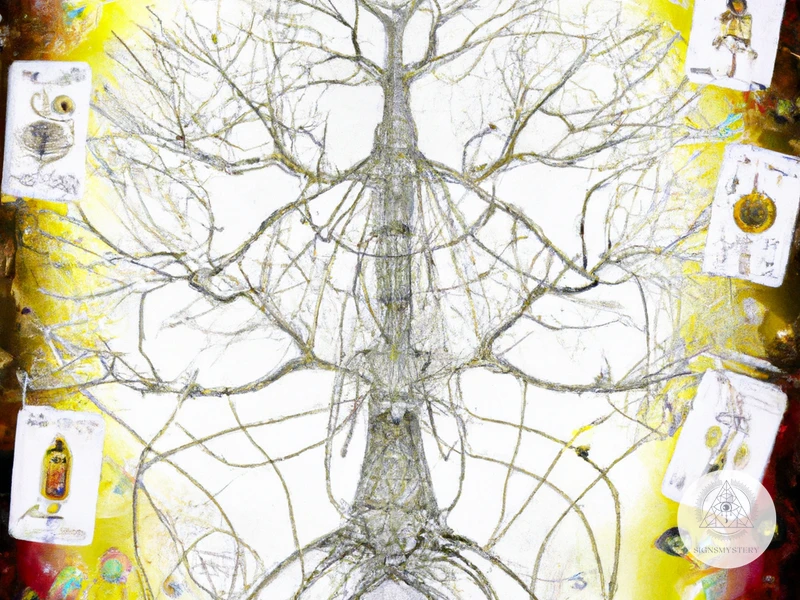
As we delve deeper into the intersection of the Tarot and the Tree of Life, we begin to uncover a multitude of fascinating correspondences. These connections shed light on the ancient wisdom that both systems embody, and they can provide insight into our own lives and paths. From the Four Worlds to the Ten Plagues of Egypt, each correspondence adds a layer of meaning and depth to our understanding of these mystical traditions. So, let’s explore some of the most intriguing correspondences between the Tarot and the Tree of Life.
The Four Worlds
The concept of the Four Worlds is an essential part of the Kabbalistic Tree of Life. The Four Worlds represent different levels of existence, with each world building upon the previous world. The Four Worlds are Atziluth, Briah, Yetzirah, and Assiah.
Atziluth is the highest of the Four Worlds and is often referred to as the world of emanation. Atziluth is connected to the sephirah Kether, which represents the infinite and unknowable aspect of God. In Atziluth, everything is perfect and unified. It is the realm of pure spirit, and as such, is not directly accessible to our physical world.
Briah, the world of creation, is the next level down from Atziluth. This world is associated with the sephirah Chokmah and Binah, which represent wisdom and understanding. Briah is the realm where the archetypes of creation are formed, and where the divine plan for the universe is first conceived.
Yetzirah, the world of formation, is associated with the sephirah Hod and Netzach, which represent splendor and victory. In Yetzirah, the archetypes of Briah are given form and shape. This is the realm of the angels and other celestial entities that reside between the physical and spiritual worlds.
Assiah, the world of action, is the lowest of the Four Worlds and is associated with the sephirah Malkuth, which represents the material world. Assiah is the realm where physical creation takes place, where matter is formed into tangible objects. It is the world that we experience through our senses.
Understanding the Four Worlds is important in Tarot as it can be used to deepen one’s understanding of the cards. Each world has different associations with the Tarot, with the major arcana being linked to the higher worlds and the minor arcana to the lower worlds. By understanding the correspondences between the Tarot and the Four Worlds, a Tarot reader can gain greater insight into the cards and their meanings.
The Elements
In Tarot, the four elements of nature: Earth, Air, Fire, and Water are significant symbols. These elements are not only relevant in Tarot but also in many magical practices. As per the Kabbalah and the Tree of Life, each sephira and path, as well as the Four Worlds, is associated with one of these elements. Here, we explore the correspondences between the elements and the Tree of Life.
– Earth: Associated with the sephira of Malkuth, which represents the material world or physical existence. Malkuth is the foundation for the rest of the Tree, and it helps to ground us. This sephira is also associated with the suit of Pentacles in tarot, which represents the material aspects of life.
– Air: Associated with the sephira of Yesod, which represents the subconscious and dreams. Yesod is the foundation of the Astral plane, and it also provides a gateway to the higher realms. It is associated with the suit of Swords in tarot, which represents the mind, communication, and logical thinking.
– Fire: Associated with the sephira of Hod, which represents intellect and creativity. Hod is the house of the energy of Mercury, which provides inspiration to artists, writers, and thinkers. It is associated with the suit of Wands, which represents creativity, passion, and action.
– Water: Associated with the sephira of Netzach, which represents emotions and intuition. Netzach is the house of Venus and is associated with love, beauty, and art. It is related to the suit of Cups, which represents emotions, relationships, and the hidden aspects of ourselves.
Understanding the correspondences between the elements and the Tree of Life can deepen our tarot practice as we apply the meanings of the elements to each card. For example, the Two of Swords represents the element of Air, which can signify difficult decisions, mental confusion, or a need for objectivity.
By using the correspondences of the elements, we can also create symbolic rituals or spells that align with the energy of a specific element or sephira. For instance, if we want to focus on grounding and manifesting in the physical world, we can work with the element of Earth and Meditate on the sephira of Malkuth.
The elements are not just symbols but also serve as connections between the Tree of Life and tarot. Understanding the correspondences of the elements helps us to deepen our understanding of both tarot and magical practices. These symbolic associations can be incorporated into various rituals and practices to work with specific elements, sephiroth, or paths.
The Zodiac
One of the most popular ways to explore the correspondences between the Tree of Life and Tarot is through the Zodiac. The Zodiac features a total of 12 signs, each representing different archetypes and energies. Each of these signs can be associated with a particular card from the Major Arcana and a specific Sephirah on the Tree of Life. To understand the correspondences between the Zodiac and Tarot, it’s important to explore each sign in detail.
Aries: Aries is associated with the Emperor card and the Sephirah of Chokmah. This sign represents assertiveness, leadership, and confidence.
Taurus: Taurus is associated with the Hierophant card and the Sephirah of Binah. This sign represents stability, practicality, and tradition.
Gemini: Gemini is associated with the Lovers card and the Sephirah of Tiphereth. This sign represents adaptability, communication, and curiosity.
Cancer: Cancer is associated with the Chariot card and the Sephirah of Netzach. This sign represents emotion, nurturing, and protection.
Leo: Leo is associated with the Strength card and the Sephirah of Chesed. This sign represents creativity, confidence, and self-expression.
Virgo: Virgo is associated with the Hermit card and the Sephirah of Geburah. This sign represents organization, practicality, and analysis.
Libra: Libra is associated with the Justice card and the Sephirah of Hod. This sign represents balance, fairness, and harmony.
Scorpio: Scorpio is associated with the Death card and the Sephirah of Netzach. This sign represents transformation, change, and rebirth.
Sagittarius: Sagittarius is associated with the Temperance card and the Sephirah of Yesod. This sign represents exploration, optimism, and growth.
Capricorn: Capricorn is associated with the Devil card and the Sephirah of Binah. This sign represents structure, discipline, and ambition.
Aquarius: Aquarius is associated with the Star card and the Sephirah of Chesed. This sign represents innovation, independence, and humanitarianism.
Pisces: Pisces is associated with the Moon card and the Sephirah of Netzach. This sign represents intuition, empathy, and sensitivity.
By exploring the correspondences between the Zodiac and Tarot, we can gain a deeper understanding of the interconnectedness between these systems. By incorporating this knowledge into our Tarot practice, we can enhance our readings and gain a greater appreciation for the wisdom contained within these ancient systems.
The Hebrew Alphabet
In addition to the Four Worlds, the Elements, the Zodiac, and the Ten Plagues of Egypt, the Hebrew Alphabet is also an important correspondence system in both the Tree of Life and Tarot. In fact, each of the twenty-two cards in the Major Arcana is associated with one of the twenty-two letters in the Hebrew alphabet.
Let’s take a closer look at the correspondence between the Major Arcana and the Hebrew Alphabet:
| Letter | Card | Meaning |
|---|---|---|
| Aleph | The Fool (0) | Beginnings, potential, new opportunities, risk-taking |
| Bet | The Magician (I) | Manifestation, action, skills, communication |
| Gimel | The High Priestess (II) | Intuition, hidden knowledge, mysteries, the unconscious |
| Dalet | The Empress (III) | Nurturing, abundance, creativity, fertility |
| Heh | The Emperor (IV) | Structure, stability, authority, protection |
| Vav | The Hierophant (V) | Tradition, spirituality, guidance, education |
| Zayin | The Lovers (VI) | Relationships, partnerships,Subscribe to Our NewsletterSign up to receive the latest news and updates. |
| Het | The Chariot (VII) | Willpower, direction, overcoming obstacles, victory |
| Tet | Strength (VIII) | Inner strength, courage, patience, self-control |
| Yod | The Hermit (IX) | Solitude, introspection, wisdom, enlightenment |
| Kaf | Wheel of Fortune (X) | Cycles, change, destiny, unexpected events |
| Lamed | Justice (XI) | Fairness, balance, truth, karmic consequences |
| Mem | The Hanged Man (XII) | Surrender, letting go, sacrifice, suspension |
| Nun | Death (XIII) | Transformation, endings, rebirth, regeneration |
| Samekh | Temperance (XIV) | Moderation, harmony, healing, integration |
| Ayin | The Devil (XV) | Lust, temptation, materialism, addictive patterns |
| Pe | The Tower (XVI) | Upheaval, crisis, shock, sudden change |
| Tzaddi | The Star (XVII) | Hope, inspiration, optimism, faith |
| Qoph | The Moon (XVIII) | Illusion, fear, subconscious, cycles of life |
| Resh | The Sun (XIX) | Renewal, vitality, joy, enlightenment |
| Shin | Judgment (XX) | Reckoning, transformation, renewal, redemption |
| Tav | The World (XXI) | Fulfillment, completion, accomplishment, integration |
Each of these correspondences can provide insight and depth to a tarot reading or meditation, and can also help to deepen one’s understanding and appreciation of the Tree of Life. As you work with these correspondences, you may begin to see new connections and associations between the cards, the Tree, and the Hebrew letters, creating a rich tapestry of symbolism that can enhance your spiritual and personal growth.
The Ten Plagues of Egypt
The Ten Plagues of Egypt are a fascinating set of correspondences that can be applied to both the Tree of Life and the Tarot. These plagues are a central part of the Passover story in Jewish tradition and are said to have been the ten calamities that God inflicted upon the Egyptians to convince Pharaoh to release the Israelites from slavery.
In Tarot, the Ten Plagues are often associated with the Ten of Swords, a card that traditionally represents the ultimate downfall or destruction. Each of the plagues corresponds to a specific Sephirah on the Tree of Life, as well as a specific suit of the Minor Arcana.
To better understand these correspondences, let’s take a look at the table below:
| Plague | Sephirah | Tarot Suit |
|---|---|---|
| Blood | Binah | Cups |
| Frogs | Hod | Cups |
| Lice | Malkuth | Pentacles |
| Wild Beasts | Hod | Wands |
| Cattle Disease | Tiphareth | Pentacles |
| Boils | Binah | Swords |
| Hail | Chesed | Swords |
| Locusts | Hod | Wands |
| Darkness | Kether | Swords |
| Death of Firstborn | Yesod | Swords |
As we can see, each plague corresponds to a different Sephirah on the Tree of Life and a different Tarot suit. For example, the first plague of Blood is associated with Binah and the Cups suit. This suggests that the emotional and intuitive aspects of Binah may be linked to the idea of blood, which is often seen as a symbol of life force and vitality.
The Ten Plagues of Egypt can be a powerful tool for exploring correspondences between the Tree of Life and the Tarot. By understanding the connections between these ancient stories and concepts and our modern understanding of the cards and the Tree, we can deepen our own spiritual practice and gain new insights into the workings of the universe.
The Benefits of Exploring Correspondences
Exploring the correspondences between the Tree of Life and Tarot can have many benefits. One of the main benefits is gaining a deeper understanding of the connections between different aspects of life. By examining the relationships between the Sephiroth, paths, tarot cards, and other correspondences, you can develop a more holistic view of the world, and your place in it.
Another benefit is enhancing your tarot practice. By understanding the connections between tarot cards and the Tree of Life, you can gain new insights into the meaning of individual cards, and how they relate to each other in a reading. This can allow you to provide more detailed and accurate readings for yourself and others.
Additionally, exploring the correspondences can help you to better understand your own spiritual journey. By studying the symbolism and meaning of different aspects of the Tree of Life and tarot, you can gain insight into your own personal beliefs and values, and how they relate to the world around you.
Exploring the correspondences between the Tree of Life and tarot can provide a wealth of benefits, from gaining a broader perspective on life, to enhancing your tarot readings, to better understanding your own spiritual journey. By taking the time to study these correspondences, you can deepen your knowledge and appreciation of both the Tree of Life and the tarot, and use this knowledge to enrich your life and the lives of those around you.
How to Use the Correspondences in Your Tarot Practice
Once you have a good understanding of the correspondences between the Tree of Life and Tarot, you can start using them in your tarot practice to deepen your readings and gain a deeper understanding of the cards. Here are some ways you can use the correspondences:
Card Pairings: One way to incorporate the Tree of Life correspondences into your readings is by pairing cards with their corresponding paths or sephiroth. For example, if you draw the High Priestess card, you can pair it with the path of Gimel. This can provide insight into the card’s meanings and how it relates to other cards in the spread.
Meditation and Visualization: Another way to use the correspondences is through meditation and visualization. You can visualize yourself walking through the Tree of Life, starting at Malkuth and moving up towards Kether. As you move through each sephiroth, you can call upon the corresponding tarot card to help you gain a deeper understanding of its meaning.
Elemental Correspondences: You can also use the elemental correspondences in your tarot readings. Each suit in the minor arcana is associated with an element: Wands with fire, Cups with water, Swords with air, and Pentacles with earth. You can use this information to gain a deeper understanding of the meaning of each card, and how it relates to the element it represents.
Astrological Correspondences: Similarly, each tarot card is associated with a specific astrological sign. For example, The Emperor is associated with Aries, The Empress with Venus, and The Sun with Leo. You can use this information to gain insight into the energies and themes associated with each sign.
Numerological Correspondences: The numbers on each tarot card also hold significance. Each number is associated with a specific energy and can provide insight into the meaning of the card. For example, the number three is associated with creativity and growth, which is reflected in the meanings of cards such as The Empress and The Three of Cups.
By incorporating these correspondences into your tarot practice, you can gain a deeper understanding of the cards and the energies behind them. This can help you to provide more accurate and insightful readings for yourself and others.
Conclusion
In conclusion, the exploration of correspondences between the Tree of Life and Tarot can offer a deeper understanding of both systems. By recognizing the interconnectedness between the Sephiroth, paths, and Tarot cards, practitioners can enhance their Tarot practice and tap into a broader sense of spiritual connectivity. The traditional methods of linking the Tree of Life and Tarot can serve as a starting point for study, but it is important to also allow for personal interpretation and exploration.
The diverse correspondences between the Tree of Life and Tarot offer countless avenues for further study and integration. Whether it be delving into the four worlds, the elements, the zodiac, the Hebrew alphabet, or the ten plagues of Egypt, each system has its own unique contribution to the overall web of interconnectedness. These correspondences can be used not only for personal reflection but can also enhance the clarity and depth of Tarot readings.
Overall, the study of correspondences between the Tree of Life and Tarot is a valuable tool for anyone seeking to deepen their spiritual practice. By exploring these interconnected systems, we can gain a profound understanding of ourselves, the world around us, and the divine forces at play in our lives.
Frequently Asked Questions
What is the Tree of Life in Tarot?
The Tree of Life is a symbol that represents the structure of the universe, and it is often used as a framework for understanding various spiritual and mystical concepts.
What are the Sephiroth in the Tree of Life?
The Sephiroth are ten spheres of divine energy that exist within the Tree of Life. Each sphere represents a different aspect of existence and consciousness.
What are the Paths in the Tree of Life?
The Paths are twenty-two lines or channels that connect the Sephiroth. Each path is associated with a different letter of the Hebrew alphabet and represents a stage in the process of spiritual growth.
What is the Major Arcana in Tarot?
The Major Arcana is a set of twenty-two cards that are considered the most significant in a Tarot deck. Each card represents a different archetypal energy and can be used for divination or self-discovery.
What is the Minor Arcana in Tarot?
The Minor Arcana is a set of fifty-six cards that are divided into four suits: Wands, Cups, Swords, and Pentacles. Each suit represents a different aspect of life, and the cards within each suit reflect different stages of growth and development.
What are the Four Worlds in Tarot?
The Four Worlds are a concept from Kabbalistic mysticism that represents different levels of consciousness and existence. These worlds are Atziluth, Briah, Yetzirah, and Assiah.
What are the Elements in Tarot?
The Elements are four basic building blocks of the universe: Fire, Water, Air, and Earth. These elements are often associated with the suits of the Minor Arcana.
What is the Hebrew Alphabet in Tarot?
The Hebrew Alphabet is a set of twenty-two letters that are associated with the paths in the Tree of Life. Each letter has its own meaning and symbolism that can be used for divination and spiritual exploration.
What are the Ten Plagues of Egypt in Tarot?
The Ten Plagues of Egypt are a set of catastrophic events that were said to have been visited upon the Egyptians in the story of the Exodus in the Bible. In Tarot, these plagues are often used as a framework for understanding cycles of growth and transformation.
How can exploring correspondences benefit your Tarot practice?
Exploring correspondences can help you deepen your understanding of the Tarot and the universe as a whole. It can also provide new insights and perspectives that can enhance your divinatory practice.
How can you use correspondences in your Tarot practice?
Correspondences can be used in many ways in a Tarot practice, such as choosing cards for meditation, creating rituals or spells, or using them to deepen your understanding of a reading or a particular concept.



